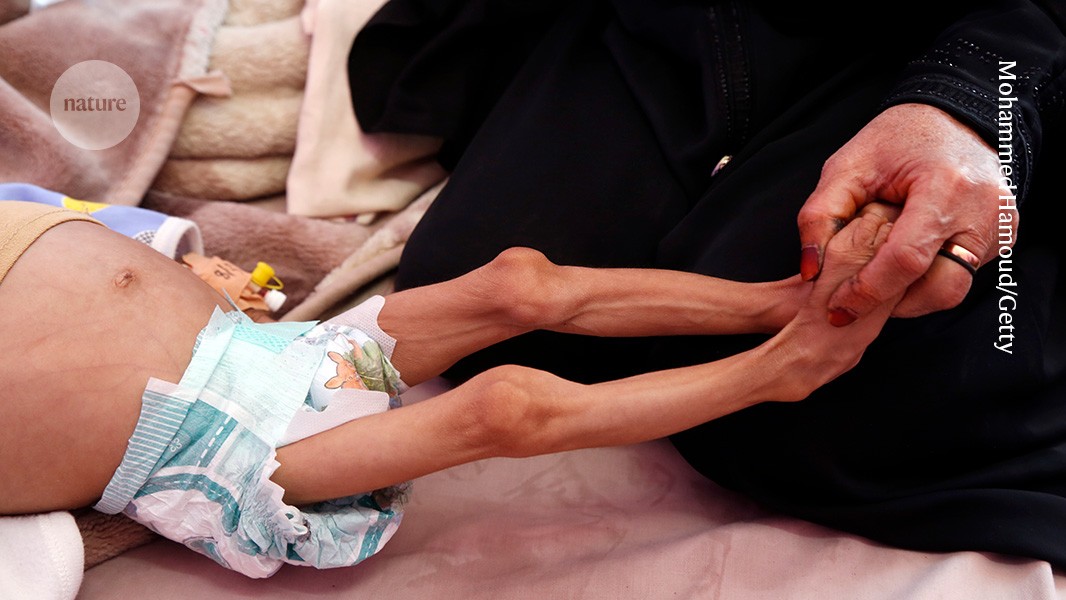Famine exposure in the womb doubles diabetes risk decades later

Study of more than ten million people suggests that early gestation is the most vulnerable time to be exposed to malnutrition

Children born in famine experience well-documented immediate effects, such as malnutrition, but pinpointing the health consequences decades later has been challenging.Credit: Mohammed Hamoud/Getty
People who were exposed to famine while in the womb shortly after they were conceived are more than twice as likely to develop diabetes as adults than are those who did not experience extreme food shortages in early gestation, according to a study1 of more than ten million people born in Ukraine almost a century ago.
The findings, published today in Science, offer a window into the long-term health impacts of famines during pregnancy. The massive study also pinpoints the specific period when developing infants are most vulnerable to poor nutrition, says Peter Klimek, a data scientist who specializes in epidemiology at the Supply Chain Intelligence Institute Austria in Vienna. “I haven’t seen anything where this has been done more comprehensively,” says Klimek, who co-authored a perspective article2 published alongside the study.
Lasting effects
Although the immediate and short-term effects of famines3 — such as malnutrition and nutritional deficiencies — are well documented, pinpointing the health consequences that people experience decades later has been challenging. Such studies require researchers to track large groups of people consistently over time, says L. H. Lumey, an epidemiologist at Columbia University in New York City and a co-author of the latest work. Previous studies conducted in Austria4 and the Netherlands5 have found hints that exposure to famine during pregnancy can increase an infant’s risk of developing diabetes later in life. But these studies were relatively small or had uncertainties about famine severity and people’s exposure to it, says Klimek.
Lumey says the Holodomor famine from 1932 to 1933 in Ukraine, which resulted in roughly four million deaths in the short term, provided an opportunity to examine the link between prenatal food shortages and diabetes risk. The famine has a well-defined time frame, affected a very large number of people and was documented thoroughly, he says.
With his colleagues, Lumey pulled together birth data on 10,186,016 Ukrainians who were born between 1930 and 1938. Among these were more than 128,000 people who were diagnosed with type 2 diabetes during the early years of the twentieth century.
Twice the risk
To estimate the severity of the famine each person experienced, the team analysed the number of excess deaths that occurred in 23 Ukrainian regions, including 16 that were impacted by food shortages, and classified the areas as experiencing extreme, very severe, severe or no famine.
The group found that people born in early 1934 — who would have been conceived during the peak of the famine — had a greater overall risk of developing type 2 diabetes as adults than did those who were not exposed to famine during the early stages of their development. Among the people who were conceived in regions that experienced extreme famine, the risk of developing the condition more than doubled. Those exposed to severe famine in utero were still roughly 1.5 times more likely to develop type 2 diabetes decades after birth than were those in regions with no famine.
There was no increase in diabetes risk among people who were in the later stages gestation during the famine, suggesting that early pregnancy is the most vulnerable time to be exposed to malnutrition.
The findings lay the foundation for researchers to conduct animal studies to tease apart the mechanisms behind the increased risk of diabetes. For example, it might be triggered by mutations to the fetus’s DNA during the famine, called epigenetic changes. “We have this event that biologists can now start chewing on,” says Lumey.
doi: https://doi.org/10.1038/d41586-024-02563-7
This story originally appeared on: Nature - Author:Gemma Conroy


















